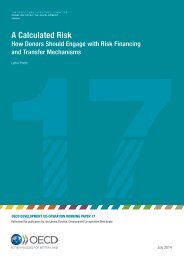UNIVERSITY
Livelihood_resilience_working_paper22
Livelihood_resilience_working_paper22
You also want an ePaper? Increase the reach of your titles
YUMPU automatically turns print PDFs into web optimized ePapers that Google loves.
Recommendation 5: <br />
Include identity and attachment to place in adaptation responses xlvii <br />
Global policy framework should consider people who are at risk of natural disasters or <br />
environmental stressors and who are not willing to migrate because they strongly identify with or <br />
feel attached to the place where they live. Adaptation strategies that allow people to live in places <br />
where they can function most effectively should be supported. Such strategies enable livelihoods to <br />
be compatible with a sense of identity and attachment to place. Adaptation strategies that include <br />
an understanding of sense of identity and attachment to place can help build livelihood resilience <br />
and protect socio-‐cultural wellbeing without giving rise to popular resistance. <br />
Identity and place attachment are key contributors to wellbeing since they influence one’s sense of <br />
security, good social relations and one’s ability to control their environment (Narayan et al. 2000; <br />
Stedman 2002; Lewicka 2011). A shared sense of identity is important for community cohesion, <br />
problem solving and successful group action against threats to livelihoods (Morrissey & Oliver-‐Smith <br />
2013; Fresque-‐Baxter & Armitage 2012; Devine-‐Wright 2013). Therefore, place attachment and <br />
identity can increase resilience by producing high levels of self-‐efficacy and enabling positive <br />
interactions with other members of the community. <br />
Livelihoods can be a strong determinant of identity and wellbeing, especially in places where people <br />
are dependent on particular sets of natural resources. For many people, switching to alternative <br />
income sources is highly undesirable and sometimes even impossible. For example, some traditional <br />
fishermen in Bangladesh will not take up casual labour opportunities, even if they are struggling <br />
financially, because they see alternative livelihoods as less honourable. Additionally, difficulties can <br />
also arise when people have to make decisions between sense of identity (moving location but <br />
maintaining livelihood source) and sense of place (staying in location and changing livelihood source) <br />
(Marshall et al. 2012). <br />
The consideration of socio-‐cultural ‘unwillingness’ to migrate – avoiding non-‐economic losses and <br />
damages such as loss of identity or loss of place-‐attachment – have to be included in a global <br />
adaptation response model to climatic impacts and environmental stress. When seeking to combat <br />
and confront climatic impacts, the goal needs to be ensuring human wellbeing and sustainable <br />
livelihoods for all. <br />
xlvii This recommendation was originally drafted by Helen Adams, David Wrathall, Stephanie Andrei, Koko Warner and <br />
Sonja Ayeb-‐Karlsson during the second Resilience Academy and subsequently edited by Sonja Ayeb-‐Karlsson, Thomas <br />
Tanner, Kees van der Geest and Koko Warner who take full responsibility for the content.



